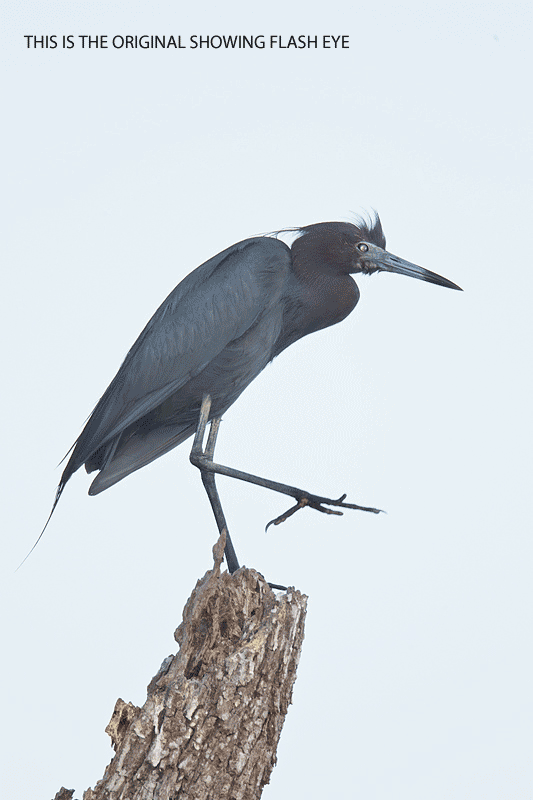St. Augustine Alligator Farm Mystery Solved!
I searched for more than an hour while preparing the Afternoon Farming Lessons post and was unable to find the info on the St. Augustine Alligator Farms great Photo Pass membership. The farm’s Gen Anderson kindly sent me the link. To learn how to get in often and early at a great price, click here. The Alligator Farm is located south of Jacksonville and north of Daytona Beach, FL.

|
Photoshop and In-the-Field Tips and Tricks
Take a moment to let the three frame animated GIF above play. The first frame was my favorite but due to the very low light–it was created well after the sun had dropped behind the trees–the eye was a flashed mess. When you are making lots of images using the flash it is likely that with some of the images the flash will not fire even if you are using a Better Beamer and and external battery pack. That, however, is not always a bad thing. Here I took the eye from the unflashed image and–using a Quick Mask–brought it into the original image. The third frame in the animated GIF is a JPEG that represents the optimized master file. Notice that in addition to replacing the flash eye I brightened and whitened the sky (using Selective Color), did a bunch of bad feather replacement on the head and around the base of the bill (using the Patch Tool), and eliminated a small section of the perch tree (bottom left–using the Clone Stamp). The tree BTW is the same tall tree that was mentioned in Afternoon Farming Lessons II.
You can learn the basics of Quick Masking and our the latest skinny on using the Clone Stamp Tool and the amazing Patch Tool in our Digital Basics File. In addition, Digital Basics also includes tips and techniques on repairing flash damaged eyes in the Digital Eye Doctor section as well as detailed instructions on getting the color you want using Selective Color. And you can learn advanced Quick Masking techniques in Robert O’Toole’s APTATS I.
The images were created with the Canon 800mm f/5.L IS lens, the EF 1.4X III TC, and the EOS-1D Mark IV. ISO 800. Evaluative metering +2 stops: 1/125 sec. at f/8 in Manual Mode. Manual flash at 1:1 with the Canon 580 EX II Speedlight. (Using the Canon external battery pack allows for more consecutive flashes and faster recharging times; see additional details in the Shopper’s Guide below).
You can learn everything that you need to know about using flash for nature photography (including Fill Flash, Flash as Main Light, and Manual Flash) in the Flash Simplified section of The Art of Bird Photography II (916 pages on CD only).
Shopper’s Guide
Below is a list of the gear that I used to create the images above (along with some related items). Thanks a stack to all who have used the Shopper’s Guide links to purchase their gear as a thank you for all the free information that we bring you on the Blog and in the Bulletins. Before you purchase anything be sure to check out the advice in our Shopper’s Guide.
Canon 800mm f/5.L IS lens. Right now this is my all time favorite super-telephoto lens.
Canon 1.4X III TC. This new Series III TC is designed to work best with the new Series II super-telephoto lenses.
Canon EOS-1D Mark IV professional digital camera body. My workhorse professional digital camera bodies.
Canon 580 EX II Speedlight. This is Canon’s most powerful, top of the line flash.
Canon CP-E4 Compact Battery Pack. Powers the flash. Allows more consecutive flashes and faster recharging times.
And from the BAA On-line Store:
Better Beamer. Using a Better Beamer with long lenses concentrates the light from the flash and yields an increase in flash output of about 2 2/3 stops, allows you to work at greater distances with smaller apertures, reduces battery drain, weighs just 2 1/2 ounces, and holds the Fresnel lens in place with no sagging or flopping. It fits in your pocket and set up and removal is quick and easy.
Gitzo GT3530LS Tripod. This one will last you a lifetime.
Mongoose M3.6 Tripod Head. Right now this is the best tripod head around for use with lenses that weigh less than 9 pounds. For heavier lenses, check out the Wimberley V2 head.
Mongoose Integrated Flash Arm. Lightweight yet fully functional. This accessory allows you to mount the flash well above the central axis of the lens thus eliminating or reducing problems with red-eye, flash-eye, steel eye, purple eye with birds and green eye with many mammals.
ProMaster Flash Cord. This flash cord is sturdy and reliable.
Delkin 32gb e-Film Pro Compact Flash Card. These high capacity cards are fast and dependable.
I pack my 800 and tons of other gear in my ThinkTank Airport SecurityTM V2.0 rolling bag for all of my air travel and recommend the slightly smaller Airport InternationalTM V2.0 for most folks. These high capacity bags are well constructed and protect my gear when I have to gate check it on short-hops and puddle jumpers. Each will protect your gear just as well. By clicking on either link or the logo below, you will receive a free gear bag with each order over $50.
















Thanks for your kind words Sarah. It is very easily to improve rapidly with digital if you study and practice. Coming to the seminar will be a great first step. Do you have ABP II?
Hi Art
I’m so excited! I’m going to Ct for your seminar. I’ll be the one all bug eyes all day! I’ve learned so much from your blogs, like so many others. Lately I’m realizing how big the gap is between my work and yours but I’ve got to just stop comparing myself to the master and get out of this slump. Dedication, commitment and love, that’s all it takes. See you soon!
best
Sarah
MB, Yes, Little Blue Heron. Scratching :).
Mario, Do realize that if you do not have a good eye to borrow from another frame that you can use Digital Eye Doctor techniques to eliminate flash eye as I did with the Laysan Albatross image in Silhouette Flash Lessons here. But creating source material in the field is the way to go; we all learn to need to think digitally while we are in the field. I do need to figure out a way to teach folks to create the animated GIFs so thanks for the suggestion.
When I think of how many images I have discarded because of problems like a flash-eye and here Artie has the perfect solution! I also love your animated GIFs – may I suggest you include how you create these in your next DB update please?
Thanks once again for the marvelous image Art! It’s images like this that keep people like me coming back to your site over and over. You are definitely a master – – but please don’t forget to mention the name of the magnificent subject. Those of us that haven’t spent lots of time in your part of the world have never seen or maybe even heard of a Little Blue Heron, a true gift of nature worthy of celebration. We mustn’t let technique get in the way of why we photograph birds in the first palce.